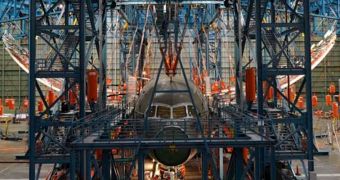On Sunday, March 28, engineers and workers at Boeing managed to successfully complete the final wing test on the static unit for their new airplane, the Boeing 787 Dreamliner. The test rig, which is basically a full-scale airplane affixed to various scaffolds and technical equipments, is used to test new technologies, or to conduct structural integrity assessments. Yesterday, the Ultimate-Load Wing Test was conducted, which sought to see how the wings of the future airplane would handle enormous stress.
The thing about this study is that it subjected the model airplane to forces that it will never experience in real-life. However, officials at Boeing seem intent not to let any angles go unchecked. As the machines around the static aircraft exerted their mechanical forces onto it, the wings were bent and flexed upwards by about 25 feet (7.6 meters). This kind of deformation is equivalent to the new Dreamliner experiencing 150 percent of the most extreme conditions it is ever likely to meet while in active duty. The airframe held on remarkably, engineers say, and preliminary readings show everything to be in order.
However, more analysis of the results is needed to see if indeed the airplane could survive the actual, real-life scenario. “The test program has been more robust than any conducted on a Boeing commercial jetliner. It has taken countless hours of hard work by the Boeing team and our partners to work through the static test program. Everyone who has been involved in this effort over the past several years should be very proud of their contributions to ensuring the safety of the 787 Dreamliner,” says the Boeing Commercial Airplanes Vice President and General Manager of the 787 program, Scott Fancher. “We are looking forward to the technical team’s report on the details of the test results,” the expert adds, saying that the team will need several weeks to browse all the collected data. During the tests, which took more than two hours to complete, sensors affixed on the wings collected thousands of data points each second. Putting them all together will allow engineers to watch how the wings bend, and then assess the risk level these bends place on the actual aircraft.
The aircraft is mid-sized, which means that it can accommodate as many as 290 to 330 passengers, depending on the final configuration of its available internal space. It features a wide-body construction type, which appears to be very popular with manufacturing companies at this time. It is powered by two General Electric GEnx or Rolls-Royce Trent 1000 engines, which are able to deliver between 53,000 and 70,000 pounds of thrust (lbf), depending on the 787 variant they are outfitted on.
“This is an aircraft that changes the whole basis of flying, because of the equipment onboard. In terms of the cost of operation this is an 80% composite material aircraft, with 35 tonnes of carbon-fiber reinforced plastic, so it is a light aircraft – which means it burns less fuel,” BGC Partners transport analyst Howard Wheeldon explains. He adds that Airbus is also developing a composite aircraft of its own, the A350. According to Boeing officials, plans are to deliver the first finished airplanes to its customers by Q4, 2010.

 14 DAY TRIAL //
14 DAY TRIAL //